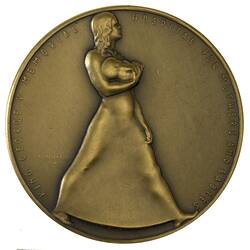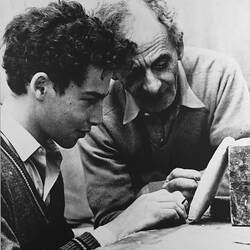Summary
Bronze art medal titled 'World Co-operation II' by Melbourne sculptor Michael Meszaros. In 1969 Meszaros received a Churchill Fellowship to study medal art in Italy at La Scuola Dell 'Art Della Medaglia, attached to Rome's main mint. His final assignment was a double-sided medal on 'World Co-operation', a theme that reflected contemporary interest in international political issues symbolised by the establishment of the Club of Rome the year before. Upon his return to Melbourne he created two one-sided medals from the designs, the Museum holds a copy of both of these medals in the collection. Their soft relief with gently defined edges is a product of the materials he used in Rome to produce the design; he would later develop a sharper, more precise style. This medal represents the sharing of the world's resources, with water pouring through many hands, but it also resembles the petal, pistils and stamens of a plant.
Physical Description
Bronze medal with an aerial view of eight pairs of hands pouring liquid into a central vessel.
Obverse Description
Overhead view of eight pairs of arms reaching into the centre. Each grasps a point of a flower-shaped object. Between the arms, the letters of WORLD COOPERATION . Around centre MESZAROS 1970 [incised family symbol - abstracted unicorn bull looking backwards over its shoulder]
Reverse Description
Plain
Significance
This is one of 44 art medals in the Museum's collection by Michael Meszaros, dated from 1960 through to 1987, which chart the evolution of a new phase of the medal tradition in Australia. While Australian medals have previously largely been commissioned works associated with official commemorations or major awards, these are personal artworks. In addition to their aesthetic value, they document nearly two decades of Australian life from a personal and popular point of view, drawing on cultural trends, sporting and leisure, and emerging issues such as environmentalism. This is a modern development in Australia, but it harks back to the European tradition, developed in the Renaissance, of medals as artistic works.
For over half a century, sculptors Andor (1900-1973) and Michael (1945- ) Meszaros have created medals that reflect the high points of life in Australia. From major awards and portraits of eminent Australians to artwork celebrating popular culture and the natural world, these objects illuminate our culture and history. Grounded in a centuries-old European art tradition, the medals create connections across disciplines and link such diverse subjects as scientific advances, religious themes, sport, the performing arts and motherhood. Through their public and private commissions and their personal artworks, the Meszaros sculptors have defined the modern Australian medal.
More Information
-
Collection Names
-
Collecting Areas
-
Acquisition Information
Cultural Gifts Donation from Jennifer M. Shaw, 08 Jun 2011
-
Acknowledgement
Donated through the Australian Government's Cultural Gifts Program by Jennifer M. Shaw
-
Date Issued
1970 AD
-
Artist
Michael Meszaros, 15 Laver St, Kew, Victoria, Australia, 1970
-
Inscriptions
Outer edge: WORLD COOPERATION
-
Material
Bronze
-
Classification
-
Category
-
Discipline
-
Type of item
-
Shape
Round
-
Keywords
International Relations, Art Medals, Sculpture, Art, Artistic Practices



